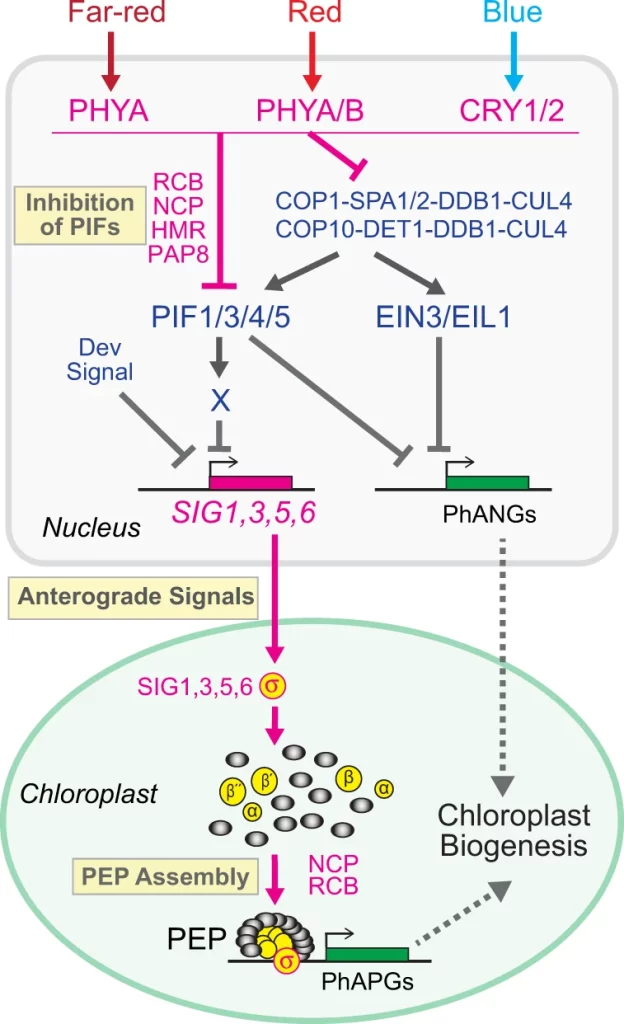Researchers at UC Riverside have made a breakthrough in understanding the signals that plants use to initiate photosynthesis, the process of converting sunlight into sugars. These signals have long been a mystery to scientists. The team’s findings offer new insights into how photosynthesis is regulated in plants.

Image Source:https://doi.org/10.1038/s41467-022-35080-0
It has been known for decades that the nucleus, the control center of a plant cell, sends signals to the cell’s other parts in the form of proteins to initiate the process of photosynthesis, which is necessary for plants to grow and turn green. These signals are critical for the proper function of the plant.
Recent research has shed new light on this mystery, revealing that anterograde signaling plays a key role in the control of plastid transcription, a process necessary for photosynthesis to occur. Plastids are organelles found in plant cells that contain pigments for photosynthesis, and in the process of transcription, the genetic information is transcribed from DNA into RNA.
The research, published in Nature Communications, shows that anterograde signaling controls plastid transcription via sigma factors, which are proteins involved in the initiation of transcription. Importantly, this control occurs separately from the induction of nuclear photosynthesis genes, which are also involved in the process of photosynthesis.
The researchers found that the genome-wide induction of nuclear photosynthesis genes is not sufficient to activate the transcription of plastid genes. Instead, the transcription of these genes is inhibited by multiple PHYTOCHROME-INTERACTING factors (PIFs) and requires the activator activity of PIF3. Among the nuclear-encoded components of the plastid transcription machinery, the researchers identified four light-inducible, PIF-repressed sigma factors as the anterograde signals that activate the transcription of plastid genes in response to light.
The findings provide a new understanding of the mechanisms behind the regulation of photosynthesis in plants and could have important implications for plant growth and development. Further research is required to thoroughly understand the role of anterograde signaling and sigma factors in the control of plastid transcription and the overall process of photosynthesis.
Final Thoughts
There is currently a lot of research on the communication between organelles and the nucleus, specifically when organelles send signals to the nucleus in response to problems or abnormalities. However, there is much less information available on the signals that are sent from the nucleus to organelles to regulate their activity. The nucleus also controls the expression of genes in mitochondria and chloroplasts in a similar way. Therefore, the principles learned from studying the communication pathway between the nucleus and chloroplasts could help researchers understand how the nucleus regulates mitochondrial genes and their role in cancer.
Understanding how photosynthesis is regulated has practical applications beyond disease research. For example, creating a suitable light scheme for indoor farming or addressing the challenges of climate change may require a better understanding of these processes.
Article Source: Reference Paper | Reference Article
Learn More:
Top Bioinformatics Books ↗
Learn more to get deeper insights into the field of bioinformatics.
Top Free Online Bioinformatics Courses ↗
Freely available courses to learn each and every aspect of bioinformatics.
Latest Bioinformatics Breakthroughs ↗
Stay updated with the latest discoveries in the field of bioinformatics.
Dr. Tamanna Anwar is a Scientist and Co-founder of the Centre of Bioinformatics Research and Technology (CBIRT). She is a passionate bioinformatics scientist and a visionary entrepreneur. Dr. Tamanna has worked as a Young Scientist at Jawaharlal Nehru University, New Delhi. She has also worked as a Postdoctoral Fellow at the University of Saskatchewan, Canada. She has several scientific research publications in high-impact research journals. Her latest endeavor is the development of a platform that acts as a one-stop solution for all bioinformatics related information as well as developing a bioinformatics news portal to report cutting-edge bioinformatics breakthroughs.







